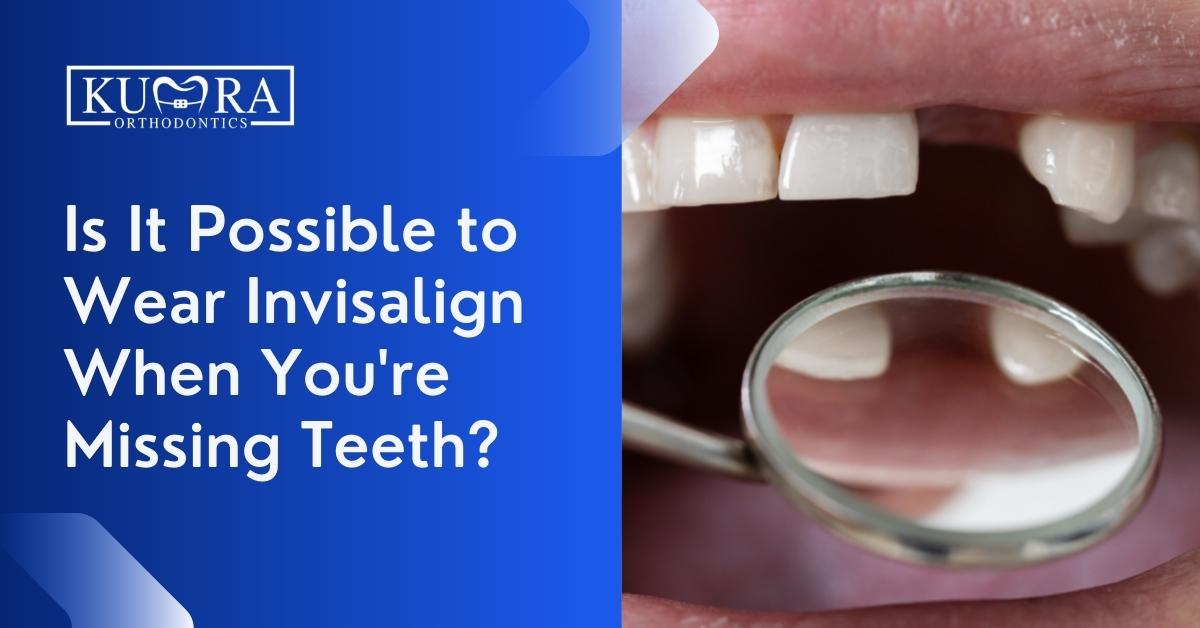Invisalign uses digital impressions of a patient’s lower and upper arches to construct a series of aligner trays that are unique to that patient. These computer-generated mouth trays will gradually apply pressure to the teeth throughout treatment in order to improve their appearance and function. Invisalign can achieve the same outcomes as traditional braces in most circumstances but with none of the drawbacks associated with metal braces, such as irritation, embarrassment, and hygienic concerns.
There is a misconception that clear aligners are not an option for people with missing teeth and dental restorations like implants and bridges. Nevertheless, patients who have lost a tooth or teeth may be suitable for this procedure as long as they have their missing tooth restored.
Invisalign with Missing Teeth
Having a missing tooth might cause the teeth around it to shift in order to fill in the space,especially when the tooth has been missing for a long time. This can lead to crooked teeth and a lack of space for a replacement tooth.
When a patient loses a tooth, they may feel self-conscious. Dental implants, crowns, denture implants, and bridgework are just a few of the tooth restoration options accessible today thanks to advances in dentistry.
Invisalign with implants are a great combination. Using an Invisalign tray has no bearing on whether or not a person has a missing tooth. They function in a similar manner. That’s because an implant replaces a tooth permanently. Despite the fact that it’s not genuine, it looks and feels like it. As a result, using an Invisalign tray has no bearing on whether or not a person has a missing tooth. They function in a similar manner.
Related: Can You Get Invisalign If You Have A Crown?
The use of Invisalign braces when teeth are absent can cause issues in some patients. If the tooth is lost due to gum disease, the gum and bone tissue around the teeth are likely to be unhealthy. For Invisalign to work, the gums and teeth must be in the best possible health.
Needing an orthodontic appointment?
Visit Kumra Orthodontics Washington, DC or Kumra Orthodontics Stafford, VA, and request an appointment with us!
What About Lost Teeth Due to Gum Disease?
Patients with periodontal issues can benefit from Invisalign orthodontics. Teeth that are crowded or crooked are more likely to develop cavities, and this, in turn, can lead to poor oral hygiene. However, if a person has lost teeth as a result of gum disease, Invisalign may be put on hold.
Effective orthodontic treatment relies on strong bones and healthy gums. During orthodontic treatment with Invisalign, teeth shift or move, causing the bone structure and gums to repair. It’s possible that unhealthy gums or bone tissue will lead to more serious dental issues, such as periodontal disease or bone loss. You’ll first require experts before starting Invisalign if you’ve been having gum problems like bleeding, swelling, or pain.
Is There Anything Invisalign Cannot Fix?
Invisalign is not the perfect solution for everyone and every situation. Overbite, crossbite, underbite, crowding, and gap teeth can all be fixed with Invisalign. However, there are some issues that can only be addressed by more traditional methods, such as braces. Invisalign, for example, cannot repair gaps between teeth more than 6 millimeters. Invisalign also cannot raise or decrease the location of a tooth in the jawline or fix a midline disparity that is more than 2 millimeters in length.
Consult with Kumra Orthodontics to learn more about Invisalign with missing teeth
If you are missing teeth and want to achieve a straighter smile, Invisalign may be the right solution for you. Kumra Orthodontics can help you determine if this option is right for your needs and walk you through the process of achieving a beautiful new smile discreetly and effectively. Contact us today to learn more about Invisalign with missing teeth!



